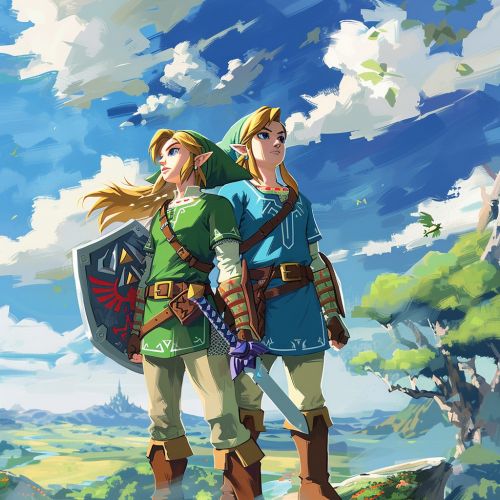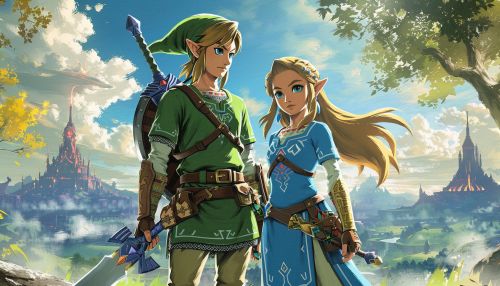The Legend of Zelda
Overview
The Legend of Zelda is a high-fantasy action-adventure video game series created by Japanese game designers Shigeru Miyamoto and Takashi Tezuka. Developed and published by Nintendo, the series debuted in Japan with The Legend of Zelda on February 21, 1986. The series centers around the various incarnations of Link, a courageous young hero, and Princess Zelda, a magical princess, as they battle to save the land of Hyrule from the evil warlord Ganon (also known as Ganondorf). The series has become one of Nintendo's most prominent and successful franchises.


Gameplay and Mechanics
The gameplay of The Legend of Zelda series incorporates a mix of action, adventure, and puzzle-solving elements. Players control Link, who must navigate through various dungeons, solve puzzles, and defeat enemies to progress. The series is known for its innovative use of items and tools, such as the Master Sword, Hylian Shield, and various other weapons and gadgets that aid in exploration and combat.
Combat System
Combat in The Legend of Zelda is typically real-time, requiring players to use a combination of swordplay, archery, and magical abilities to defeat enemies. The series introduced the concept of Z-targeting in The Legend of Zelda: Ocarina of Time, which allows players to lock onto enemies for more precise attacks.
Puzzle-Solving
Puzzles are a core component of the series, often requiring players to manipulate the environment, use specific items, or solve riddles to advance. These puzzles can range from simple block-pushing tasks to complex multi-step challenges that span entire dungeons.
Exploration
Exploration is a significant aspect of the series, with vast overworlds and intricate dungeons to discover. Players are encouraged to explore every corner of the game world to find hidden items, secret passages, and optional quests. The series often features an open-world design, allowing players to tackle objectives in a non-linear fashion.
Story and Setting
The narrative of The Legend of Zelda series is rich and complex, often involving themes of good versus evil, the hero's journey, and the cyclical nature of time. The primary setting is the kingdom of Hyrule, a land filled with diverse regions, cultures, and creatures.
Hyrule
Hyrule is the central location in most games of the series. It is a vast kingdom with various regions, including forests, mountains, lakes, and deserts. Key locations within Hyrule include Hyrule Castle, Death Mountain, and Lake Hylia.
Timeline
The series' timeline is intricate, with multiple branching paths. The official timeline, as revealed by Nintendo, splits into three separate timelines after the events of Ocarina of Time: the Child Timeline, the Adult Timeline, and the Fallen Hero Timeline. Each timeline features its own unique set of games and storylines.
Characters
The series features a recurring cast of characters, each with their own roles and significance within the lore.
Link
Link is the primary protagonist of the series. He is often depicted as a young boy or teenager wearing a green tunic and hat. Link is the chosen hero, tasked with saving Hyrule and Princess Zelda from various threats. He wields the Master Sword and possesses the Triforce of Courage.
Princess Zelda
Princess Zelda is the titular character and often plays a crucial role in the series. She is a member of the royal family of Hyrule and possesses the Triforce of Wisdom. Zelda often aids Link in his quest, sometimes taking on different forms, such as Sheik in Ocarina of Time.
Ganon/Ganondorf
Ganon, also known as Ganondorf in his human form, is the primary antagonist of the series. He is a powerful sorcerer and the king of the Gerudo tribe. Ganon seeks to obtain the Triforce to gain ultimate power and conquer Hyrule. He possesses the Triforce of Power.
Development and History
The development of The Legend of Zelda series has been spearheaded by Nintendo's Entertainment Analysis & Development (EAD) division. The series has seen contributions from various notable developers and designers.
Early Development
The original The Legend of Zelda was developed for the Nintendo Entertainment System (NES) and was one of the first games to feature a battery-backed save system, allowing players to save their progress. The game was a critical and commercial success, leading to the development of numerous sequels.
Evolution of the Series
Over the years, the series has evolved significantly, incorporating new technologies and gameplay mechanics. The Legend of Zelda: A Link to the Past introduced a more complex narrative and a dual-world mechanic. Ocarina of Time transitioned the series to 3D graphics and introduced Z-targeting, which became a staple in future games.
Recent Developments
Recent entries in the series, such as The Legend of Zelda: Breath of the Wild, have embraced open-world design and non-linear gameplay. Breath of the Wild received widespread acclaim for its innovative approach to the series' formula and has influenced the design of future games.
Cultural Impact
The Legend of Zelda series has had a profound impact on the video game industry and popular culture. It has inspired numerous other games and has a dedicated fanbase.
Influence on Gaming
The series has set benchmarks for game design, particularly in the action-adventure genre. Elements such as open-world exploration, complex puzzles, and real-time combat have been widely adopted by other games.
Merchandise and Media
The success of the series has led to various forms of merchandise, including toys, clothing, and collector's items. Additionally, the series has been adapted into an animated television show and various manga series.
See Also
- Shigeru Miyamoto
- Nintendo Entertainment System
- The Legend of Zelda: Ocarina of Time
- The Legend of Zelda: Breath of the Wild
- Hyrule
